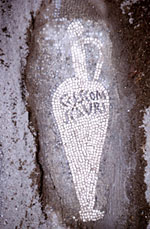Mad Men–Roman Style
by Heather Pringle
October 3, 2008
 By far and away my favorite TV show at the moment is Mad Men, that superb retro drama set at the fictional Sterling Cooper ad agency on Madison Avenue in New York during the early 1960s. I am fascinated by the characters and their shameless careerism and cynicism, and I love the producers’ obsessive attention to detail and historical accuracy. I’d forgotten how exquisite the dresses were in the sixties, how clean the offices looked without all that clunky computer equipment cluttering desks and cables running everywhere, and just how free smokers were to puff away to their heart’s content.
By far and away my favorite TV show at the moment is Mad Men, that superb retro drama set at the fictional Sterling Cooper ad agency on Madison Avenue in New York during the early 1960s. I am fascinated by the characters and their shameless careerism and cynicism, and I love the producers’ obsessive attention to detail and historical accuracy. I’d forgotten how exquisite the dresses were in the sixties, how clean the offices looked without all that clunky computer equipment cluttering desks and cables running everywhere, and just how free smokers were to puff away to their heart’s content.
It is worth remembering, however, that the real Mad Men of New York didn’t invent the art of persuasion: they merely pushed it to glossy new heights. As early as the 1st -century AD, wealthy Roman merchants had mastered branding and marketing, as I discovered while exploring the palatial residence of Umbricius Scaurus at Pompeii in the company of British archaeologist Andrew Wallace-Hadrill.
Umbricius Scaurus and his family manufactured and sold four different types of fish sauces, including the rather famous garum , to Roman households. Today people tend to turn up their noses at the thought of splashing a main course with a flavoring made from liquefied fish intestines, but I am told that it was actually very tasty. According to Robert Curtis, a professor of classics at the University of Georgia who has studied garum extensively, the popular Roman seasoning tasted much like the fish sauce found in Thai and Vietnamese cooking today.
But back to Umbricius Scaurus. As well as being a skilled manufacturer, the Campanian tycoon had a real talent for branding his products, always keeping his name in front of the consumer. The terracotta vessels that bore his fish sauces at Pompeii, for example, often carried a painted inscription, Ex Officina Scaurus , “from the shop of Scaurus.” And some even featured little advertising slogans, such as “the flower of garum , made from the mackerel, a product of Scaurus, from the shop of Agathopus.”

Umbricius Scaurus didn’t believe, however, in leaving his work at the office. In the atrium of his sprawling split-level home in Pompeii, he installed a kind of advertising billboard – a mosaic floor representing four large fish sauce vessels, most carrying Scaurus’s name. Visitors could scarcely have missed this giant commercial message. And those invited into his personal quarters probably never forgot how the owner made his fortune. The house overlooked the Mediterranean, and as Wallace-Hadrill told me, “from here, Scaurus could see his ships sailing off to Spain, carrying his fish sauce.”
Clearly Mad Men’s Don Draper had little on Umbricius Scaurus. But this week, I came across another intriguing footnote to this story. Scientists at Pompeii’s Applied Laboratory have just managed to date the Vesuvius eruption that destroyed the seaside Roman town: they obtained this date from bits of garum that still clung to seven vessels in the home of Umbricius Scaurus.
Â
My thanks to Robert Curtis, who supplied the photo of the garum vessel depicted on Scaurus’s floor.
Comments posted here do not represent the views or policies of the Archaeological Institute of America.






 Heather Pringle is a freelance science journalist who has been writing about archaeology for more than 20 years. She is the author of Master Plan: Himmler's Scholars and the Holocaust and The Mummy Congress: Science, Obsession, and the Everlasting Dead. For more about Heather, see our
Heather Pringle is a freelance science journalist who has been writing about archaeology for more than 20 years. She is the author of Master Plan: Himmler's Scholars and the Holocaust and The Mummy Congress: Science, Obsession, and the Everlasting Dead. For more about Heather, see our 



